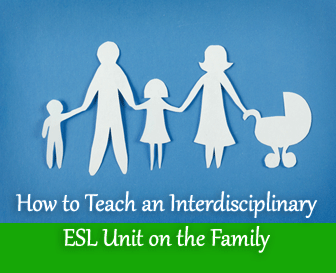Mama's House: An Interdisciplinary ESL Unit on the Family


How many children does a typical family have? Who lives together in the same house? How important is birth order in a family and a culture? All these are important questions that each student may answer differently. Because of this, teaching about family is a great opportunity to explore some of the cultural differences among your students.
Vocabulary
The first and most foundational step in teaching about family is to make sure your students know the vocabulary terms. Start with general terms like father, mother, brother and sister. Make sure your students understand the gender differences in words like niece and nephew and the lack of gender difference in words like parent and cousin. Different languages will not signal gender differences the same ways, and this may be confusing for your students. Likewise, your students may be confused with even simple words like brother that do not distinguish between older brothers and younger brothers as some languages do. Be patient in explaining these differences and let your students ask questions and share the differences in their languages.
Relationships
After your students understand the vocabulary, it is now time to examine the relationships between family members. The easiest way to do this is to create a family tree. You can either create a tree for a fictional family or use your own family as an example. Be as elaborate and as detailed as you can. As you create the tree, show how people in the family are related to each other. One person will likely be a brother to one person, a son to another person, a nephew or cousin to another. Using the family tree, you can highlight to your students how one person plays various roles. You can also point out generational differences; my mother’s grandmother is my great grandmother. My mother’s aunt is my great aunt. Only the bravest of teachers will attempt relationships as complex as second cousin once removed, but if you do even advanced students will benefit. Because of this, family is a topic that can be used with any level learner. The more advanced the student, the more complicated the relationships you can teach. This also makes family a great topic for a mixed level class since each student can find some level of comprehension that challenges him or her.
Cultural Norms
Now that you have reviewed vocabulary and relationships among family members, you can discuss the culture of families. Who typically lives in the same house? Where does a newly married couple live? How many children are typical in your culture? How are older family members treated differently from younger ones? Are there responsibilities that come with certain family roles? (e.g. oldest son or daughter) Who cares for family members when they are unable to take care of themselves? All of these are great discussion questions that will keep your students talking to each other for hours. Discussions will be especially enlightening if your class is made up of students from different cultures (see our other article called ‘How to Lead Discussions: No Need to Speak Like Obama’).
Make It Personal
You can also give your students the opportunity to share about each of their families either in front of the class or in small groups. Give them time to prepare, and then let them share. You can also use family as a topic for writing assignments. What does your family mean to you? How is your family typical of your culture? How is your family different from a family in your host culture? In addition, if they are staying with a host family, compare and contrast your host family to your family at home. Be sensitive to your students that have lost members of their family to whom they were close. Students who have lost a sibling or parent may be especially emotional when discussing family. Give them permission to share what they can, and do not make them uncomfortable by forcing them to discuss sensitive relationships.
Bring In Outside Sources
One of my favorite activities to do when teaching about family is to use movie clips that show familial relationships. One of the most entertaining is the clip from While You Were Sleeping when Sandra Bullock’s character meets her supposed fiancé’s family. The scene is quick and complicated, but taken segment by segment it shows many of the relationships present in typical families. You can use this or a scene from another movie or television show with your class. This is also a great way to bring in a book they have been reading if the book portrays a family. Have the class create a family tree for that family. Have them describe the relationships they see or read about. You can also show the movie clip before starting your lesson on family to bring the subject to the forefront of your students’ minds and get them thinking about the topic.
Do not be surprised, though, if you learn a thing or two about your students that you never would have guessed. Take the opportunity to increase your understanding of their cultures; it will only make you a better and more sensitive teacher in the long run.